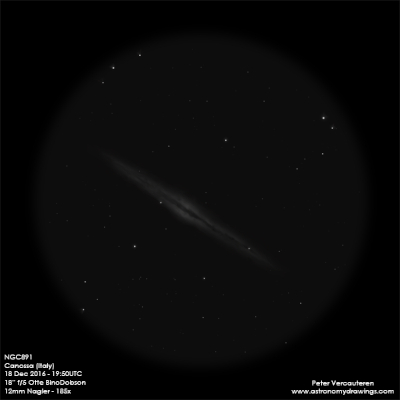
80mm (11/13/07): I was surprised how evident the galaxy appeared at 25x in the 80mm finder.
William Herschel discovered NGC 891 = H V-19 = h218 on 6 Oct 1783 and described "a considerably bright nebula about 15' long and 3' broad; its length is divided in the middle by a black division at least 3' or 4' long." On 17 Oct 1786 (sweep 614), he logged "cB, about 15' long and 2 or 3' broad, bM, nearly in the meridian, a little from sp to nf." On 24 Oct 1786 (sweep 621), he swept it again as "cB, gbM, about 15' l and 3' br, a black division in the middle in the direction of the length; at least 3 or 4' long." In the notes section of his first catalogue, William mentioned that Caroline found this object on 27 Aug 1783 in his first catalogue, but this is a transcription error in the handwritten copy sent to the printer as she found NGC 205 = M110 on that date (sketched earlier by Messier). Admiral William Smyth repeated this error in his Cycle of Celestial Objects (1844). WH also found two members of nearby Abell Galaxy Cluster 347 (NGC 898 and 910) on 17 Oct 1786. He published a sketch in his 1811 paper (Fig. 12) as an illustration of "nebulae that are remarkable for some particularity in figure or brightness."
John Herschel noted on sweep 182 that it "has a chink or dark division in the middle and two stars." He sketched the galaxy and remarked "An extraordinary object. Perhaps the figure is too nicely symmetrical as it certainly is too sharply defined. It is of the last degree of faintness and may very well be though full in the field of view. There can hardly be a doubt a thin flat ring of enormous dimensions seen very obliquely." The galaxy was also sketched at Birr Castle in 1850-51 and Dreyer noted, "I think the split is broader at one end, and that the nebula is a little more sharply defined on the following [Eastern] branch. The central part is longer, but perhaps not so bright as on the preceding branch. A bifurcation suspected at south end by Lord Rosse."
200/250mm - 8" (11/28/81): fairly bright, large, edge-on, central bulge.
300/350mm - 13" (9/11/82): dust lane visible with averted.
400/500mm - 17.5" (8/31/86): bright, extremely large, edge-on 5:1 SSW-NNE, 10'x2'. A striking dust lane bisects the galaxy and is most prominent through the bulging central region.
900/1200mm - 48" (10/25/11): at 375x, the stunning edge-on NGC 891 was one of the top highlights of the observing week with the 48". The galaxy nearly filled the 16' field, stretching nearly 12' by 2' SSW-NNE. A 17th magnitude star is superimposed close to the NNE tip and a mag 16.5 star is near the SSW end. The brighter, bulging central region extends 2.5' with a mag 12 star just north of the core on the west side. A similar star is superimposed on the southern extension along with a few fainter stars. A very high contrast dust lane slices through most of the galaxy except at the tips, where the galaxy fades out. I was surprised how broad the dust lane appeared, particularly through the central section. Although the dust lane perfectly bisects the galaxy into two symmetric halves, the edge of the lane was ragged and uneven.
MAC 0222+4222 = ZOAG G140.39-17.38 was visible just off the east edge, 2.3' NNE of center and collinear with two mag 12 and 13.3 stars off the west edge of the galaxy. It appeared as a very faint, elongated glow, ~15"x6". Once identified I could hold this galaxy nearly continuously with averted vision. In addition, an extremely compact anonymous galaxy is just 50" NW the center of NGC 891 and 40" SE of the mag 13.3 star. It was visible continuously at 375x and 488x as a faint glow, roughly 6" diameter. Surprisingly this object is not listed in NED, HyperLeda or SIMBAD, though it's probably no fainter than mag 16.5.
Notes by Steve Gottlieb